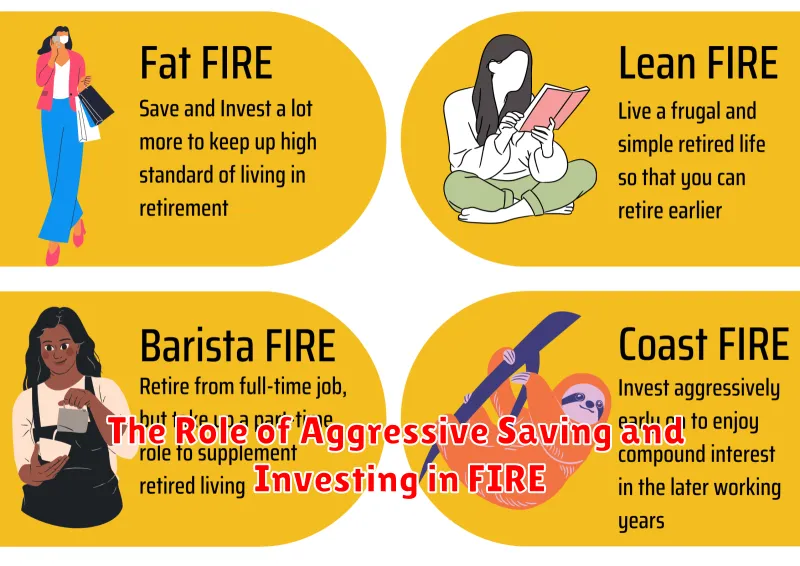Dreaming of ditching the daily grind and achieving financial independence to retire early? You’re not alone! The FIRE movement (Financial Independence, Retire Early) is gaining momentum, empowering individuals to take control of their financial futures and live life on their own terms.
This comprehensive guide delves deep into the core principles of FIRE, providing a roadmap to help you design your own personalized path towards early retirement. We’ll explore proven strategies for aggressive saving, smart investing, and calculated lifestyle adjustments – all designed to accelerate your journey to financial freedom and help you achieve your retirement goals faster.
What is the FIRE Movement?

FIRE, which stands for Financial Independence, Retire Early, is more than just a trendy acronym. It’s a growing movement of individuals seeking to take control of their finances and achieve financial freedom earlier than traditional retirement ages.
At its core, the FIRE movement encourages aggressive saving and investing strategies to build wealth and generate passive income streams. The ultimate goal? To accumulate enough assets to cover living expenses indefinitely, allowing individuals to retire early or pursue their passions without being tied to a traditional job.
Steps to Achieve Financial Independence
Achieving financial independence is a journey that requires careful planning, discipline, and consistent effort. Here are the essential steps to guide you:
1. Define Your FIRE Number: Determine the amount of money you need to sustain your desired lifestyle without relying on traditional employment. This figure represents your total financial needs multiplied by your desired annual expenses.
2. Create a Budget and Track Expenses: Gain a clear understanding of your cash flow by tracking income and expenses. Identify areas to reduce spending and redirect funds towards savings and investments.
3. Aggressively Save and Invest: Strive to save a significant portion of your income, aiming for 50% or more. Explore various investment options, such as index funds, real estate, and retirement accounts, to grow your wealth over time.
4. Increase Your Income Streams: Explore opportunities to diversify your income sources beyond your primary job. Consider side hustles, freelancing, or starting a small business.
5. Pay Off High-Interest Debt: Prioritize paying off high-interest debts, such as credit cards, as quickly as possible. This step reduces financial burden and frees up more capital for saving and investing.
6. Live Below Your Means: Adopt a frugal lifestyle and resist the urge to overspend. Differentiate between needs and wants, making conscious choices to prioritize long-term financial well-being.
7. Invest in Your Education and Skills: Continuously invest in your personal and professional development. Acquiring new knowledge and skills can lead to higher earning potential and career advancement.
8. Seek Professional Advice: Consider consulting with a financial advisor to receive personalized guidance tailored to your circumstances. They can provide insights on investment strategies, retirement planning, and tax optimization.
How to Calculate Your FIRE Number
Your FIRE number represents the total amount of money you need to have saved and invested to achieve financial independence and retire early. It’s a personalized target that considers your estimated annual expenses in retirement and your desired lifestyle.
Here’s how to calculate it:
-
Determine your annual expenses in retirement. Start by analyzing your current spending habits. Consider which expenses will decrease or disappear in retirement (like commuting costs) and which might increase (like healthcare). Factor in your desired lifestyle and any potential large expenses.
-
Choose your safe withdrawal rate (SWR). This is the percentage of your portfolio you plan to withdraw annually in retirement. A common SWR is 4%, considered a sustainable rate for a 30-year retirement. A lower SWR offers a greater safety margin.
-
Calculate your FIRE number. Divide your estimated annual expenses in retirement by your chosen SWR. For example, if you anticipate needing $50,000 per year and use a 4% SWR, your FIRE number would be $1,250,000 ($50,000 / 0.04).
Example:
- Annual Retirement Expenses: $60,000
- Safe Withdrawal Rate: 3%
- FIRE Number: $2,000,000 ($60,000 / 0.03)
Remember, this is a simplified calculation. Factors like inflation, investment returns, and unexpected life events can impact your FIRE journey. It’s crucial to regularly review and adjust your plan as needed.
The Role of Aggressive Saving and Investing in FIRE

Aggressive saving and investing form the cornerstone of the FIRE movement. This means aiming to save and invest a significantly higher proportion of your income than the traditional 10-15%. FIRE enthusiasts often target savings rates of 50% or more, drastically shortening the time it takes to reach financial independence.
High savings rates are achievable through a combination of increasing income and reducing expenses. This might involve pursuing a high-paying career, taking on side hustles, living frugally, and minimizing debt. The goal is to free up as much of your income as possible for investing.
Investing plays a critical role in growing your wealth over time. FIRE proponents typically favor a long-term, low-cost approach, often utilizing index funds and ETFs. By consistently investing a large portion of their savings, they aim to benefit from the power of compounding and build a substantial nest egg that can support their early retirement years.
How to Cut Expenses and Increase Savings
Cutting expenses and increasing savings are the cornerstones of achieving Financial Independence and Early Retirement (FIRE). It’s about making conscious choices to align your spending with your values and prioritizing long-term financial well-being over immediate gratification.
Track Your Spending: Start by understanding where your money is actually going. Utilize budgeting apps, spreadsheets, or even a simple notebook to track your income and expenses for at least a month. This will highlight areas of overspending and potential savings opportunities.
Identify Non-Essential Expenses: Once you have a clear picture of your spending habits, identify non-essential expenses that can be reduced or eliminated. These might include dining out frequently, subscriptions you don’t use, expensive hobbies, or impulse purchases.
Set Realistic Budget and Savings Goals: Create a realistic budget that aligns with your FIRE goals. Determine a savings rate that works for you – the higher the savings rate, the faster you can reach FIRE. Aim to automate your savings so that a portion of your income is directly deposited into your savings or investment accounts.
Find Savings in Housing and Transportation: Housing and transportation are often two of the largest expenses. Consider downsizing your living space, renting out a room, or exploring more affordable housing options. For transportation, utilize public transit, carpool, bike, or walk whenever possible.
Reduce Food Costs: Eating out less and cooking more meals at home can significantly reduce food expenses. Plan your meals in advance, prepare lunches to bring to work, and take advantage of leftovers.
Cut Entertainment and Shopping Expenses: Explore free or low-cost entertainment options like parks, libraries, museums, or community events. When making purchases, be mindful and prioritize needs over wants. Look for sales, discounts, or consider buying used items.
Negotiate Bills and Find Better Deals: Don’t be afraid to negotiate with service providers for lower rates on cable, internet, or insurance. Shop around for better deals on utilities, credit cards, and insurance policies.
Remember, cutting expenses and increasing savings is a journey, not a race. Small, consistent changes over time can have a significant impact on your financial well-being and bring you closer to achieving FIRE.
Risks and Challenges of Pursuing FIRE
While the idea of Financial Independence, Retire Early (FIRE) is enticing, it’s crucial to be aware of the potential risks and challenges before diving in. Achieving FIRE requires meticulous planning, discipline, and a bit of luck. Here are some key risks and challenges to consider:
1. Market Volatility: FIRE typically relies heavily on investments, and markets are inherently unpredictable. A market downturn could significantly impact your savings and delay your retirement timeline.
2. Inflation: Your expenses in retirement might be higher than anticipated due to inflation. Your savings need to outpace inflation to maintain your purchasing power over time.
3. Unexpected Expenses: Life is full of surprises, and not all of them are pleasant. Medical emergencies, home repairs, or supporting family members can throw off even the most well-planned budgets.
4. Longevity Risk: People are living longer, which means your retirement savings might need to last for several decades. Underestimating your lifespan could lead to financial strain later on.
5. Burnout: The intense saving and frugality often associated with FIRE can lead to burnout. It’s essential to find a balance to avoid sacrificing your well-being during your wealth-building years.
6. Lifestyle Creep: As your income increases, it’s tempting to upgrade your lifestyle, which can make it harder to reach your FIRE goals. Staying disciplined and avoiding lifestyle inflation is crucial.
7. Healthcare Costs: Healthcare expenses can be significant, especially in retirement. If you plan to retire early, you’ll need to factor in the cost of health insurance until you’re eligible for government programs.
8. Sequence of Returns Risk: The order in which your investments perform during your retirement can significantly impact the longevity of your savings. Negative returns early in retirement can be detrimental.
While these risks and challenges exist, they don’t mean FIRE is unattainable. By acknowledging and proactively addressing these potential obstacles, you can increase your chances of successfully achieving Financial Independence and Early Retirement.
How to Maintain Financial Independence After Early Retirement
Achieving financial independence and early retirement (FIRE) is a huge accomplishment, but the journey doesn’t end there. Maintaining that hard-earned freedom requires careful planning and ongoing vigilance. Here’s how to make sure your early retirement lasts as long as you do:
Budgeting Remains Crucial: Even without a 9-to-5, a detailed budget is your roadmap to financial security. Track your spending, adjust for inflation, and be realistic about your expenses to avoid outliving your savings.
Withdrawal Rate Discipline: Sticking to a sustainable withdrawal rate from your retirement nest egg is paramount. The commonly recommended 4% rule provides a good starting point, but factor in your individual risk tolerance and life expectancy.
Investment Strategy: Your investment approach needs to shift from accumulation to preservation and income generation. A diversified portfolio that balances risk and return potential is essential for long-term sustainability.
Healthcare Costs: Health insurance becomes a major consideration before reaching Medicare eligibility. Explore options like COBRA, private insurance, or health sharing ministries to bridge the gap and protect yourself from unexpected medical expenses.
Part-Time Income Streams: Generating some income during retirement can provide financial cushion and keep you engaged. Consider part-time work, consulting, or pursuing a passion project that brings in some revenue.
Combat Lifestyle Inflation: It’s easy to let spending creep up in retirement, especially in the early years. Be mindful of lifestyle inflation and resist the urge to overspend just because you have more free time. Staying true to your financial goals will ensure your independence lasts.

